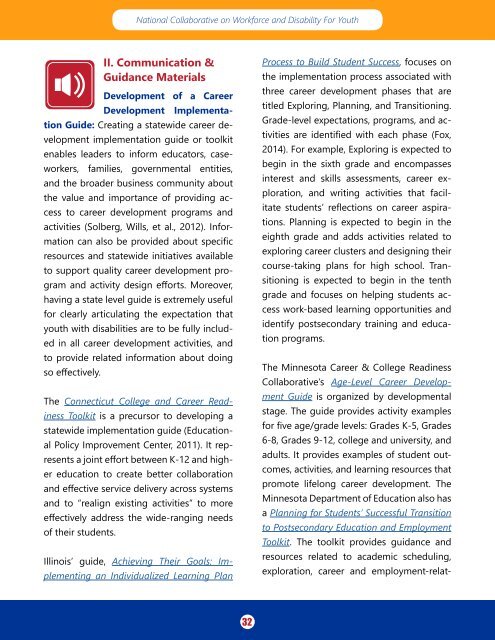Designing Statewide Strategies & Programs
DesigningStatewideCareerDevelopmentStrategiesProgramsPub_0
DesigningStatewideCareerDevelopmentStrategiesProgramsPub_0
Create successful ePaper yourself
Turn your PDF publications into a flip-book with our unique Google optimized e-Paper software.
National Collaborative on Workforce and Disability For Youth<br />
II. Communication &<br />
Guidance Materials<br />
Development of a Career<br />
Development Implementation<br />
Guide: Creating a statewide career development<br />
implementation guide or toolkit<br />
enables leaders to inform educators, caseworkers,<br />
families, governmental entities,<br />
and the broader business community about<br />
the value and importance of providing access<br />
to career development programs and<br />
activities (Solberg, Wills, et al., 2012). Information<br />
can also be provided about specific<br />
resources and statewide initiatives available<br />
to support quality career development program<br />
and activity design efforts. Moreover,<br />
having a state level guide is extremely useful<br />
for clearly articulating the expectation that<br />
youth with disabilities are to be fully included<br />
in all career development activities, and<br />
to provide related information about doing<br />
so effectively.<br />
The Connecticut College and Career Readiness<br />
Toolkit is a precursor to developing a<br />
statewide implementation guide (Educational<br />
Policy Improvement Center, 2011). It represents<br />
a joint effort between K-12 and higher<br />
education to create better collaboration<br />
and effective service delivery across systems<br />
and to “realign existing activities” to more<br />
effectively address the wide-ranging needs<br />
of their students.<br />
Illinois’ guide, Achieving Their Goals: Implementing<br />
an Individualized Learning Plan<br />
Process to Build Student Success, focuses on<br />
the implementation process associated with<br />
three career development phases that are<br />
titled Exploring, Planning, and Transitioning.<br />
Grade-level expectations, programs, and activities<br />
are identified with each phase (Fox,<br />
2014). For example, Exploring is expected to<br />
begin in the sixth grade and encompasses<br />
interest and skills assessments, career exploration,<br />
and writing activities that facilitate<br />
students’ reflections on career aspirations.<br />
Planning is expected to begin in the<br />
eighth grade and adds activities related to<br />
exploring career clusters and designing their<br />
course-taking plans for high school. Transitioning<br />
is expected to begin in the tenth<br />
grade and focuses on helping students access<br />
work-based learning opportunities and<br />
identify postsecondary training and education<br />
programs.<br />
The Minnesota Career & College Readiness<br />
Collaborative’s Age-Level Career Development<br />
Guide is organized by developmental<br />
stage. The guide provides activity examples<br />
for five age/grade levels: Grades K-5, Grades<br />
6-8, Grades 9-12, college and university, and<br />
adults. It provides examples of student outcomes,<br />
activities, and learning resources that<br />
promote lifelong career development. The<br />
Minnesota Department of Education also has<br />
a Planning for Students’ Successful Transition<br />
to Postsecondary Education and Employment<br />
Toolkit. The toolkit provides guidance and<br />
resources related to academic scheduling,<br />
exploration, career and employment-relat-<br />
32


